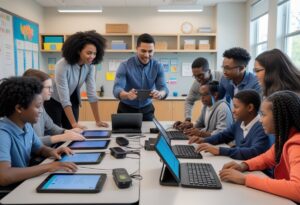Affordable Accessibility Tools for Schools on a Budget: Essential Solutions for Inclusive Learning

Supporting Student Success with Affordable Accessibility Tools
Schools today face tight budgets, but the need for accessible learning tools has never been greater. Affordable accessibility tools now make it possible for every school to support students who are visually impaired, without straining limited resources. From free or low-cost software to budget-friendly devices, there are practical solutions schools can implement right away.
At New England Low Vision and Blindness, we believe every student should have the tools they need to succeed. We’re ready to share our knowledge and experience to help educators find effective, accessible technology that works within your school’s budget. Let’s explore leading-edge affordable tools that can change lives in your classroom.
Key Features of Affordable Accessibility Tools
Affordable accessibility tools make inclusive education possible, even on tight budgets. By focusing on core functionalities, these tools support students with disabilities and help schools reach their goals for an inclusive learning environment.
Core Functionalities for Inclusive Education
Accessibility tools must address the real needs of students. Essential features include text-to-speech, speech-to-text, and screen magnifiers. These help students with low vision or blindness access digital content.
Braille displays and keyboard shortcuts improve usability for those who cannot use a mouse. Volume control, adjustable color contrast, and font resizing provide custom experiences for learners.
Having resources that work across devices—like Chromebooks, tablets, and PCs—means flexibility for every classroom. Compatibility with standard learning platforms, such as Google Classroom and Microsoft Teams, ensures seamless integration.
Benefits for Students With Disabilities
These tools give students independence and equal access. Text-to-speech allows learners who are blind or have low vision to read digital textbooks and assignments.
Speech recognition enables those with fine motor challenges to write and communicate. Note-taking apps that sync with audio help students follow class discussions easily.
Many leading-edge tools offer personalized settings. For example, students can change the reading speed or highlight text as it’s read aloud. This level of control and independence fosters a sense of empowerment in an inclusive setting.
Aligning With School Budgets
We understand that affordability is key for many school districts. Subscription-based models are now available, reducing upfront costs and allowing for scalable deployments. Many solutions provide free versions or discounts for educational institutions.
Schools often already have access to built-in accessibility features in mainstream software, such as Microsoft 365 or Google Workspace, at no extra charge. Leveraging these built-in tools can minimize additional expenses.
It is also important to consider training and support services included in the software package. Many vendors offer resources and tutorials, reducing the time needed to implement and maintain these tools in the classroom.
Essential Low-Cost Assistive Technologies
When working with a limited budget, we need effective tools that support students who are visually impaired. There are affordable options that make our classrooms more accessible without sacrificing quality or essential features.
Screen Readers and Text-to-Speech Solutions
Screen readers and text-to-speech software are vital for students who have difficulty reading standard printed or digital text. NonVisual Desktop Access (NVDA) stands out as a free and reliable screen reader for Windows computers. It reads what is on the screen and navigates digital content using speech or Braille output.
Free browser extensions such as Read Aloud for Chrome or Edge and built-in tools in devices like VoiceOver on Apple devices let students hear textbooks, assignments, and emails. These tools improve comprehension for students with low vision or reading disabilities. They are easy to install, need little training, and can be customized for voice, speed, and language.
Table: Popular Free or Low-Cost Screen Readers
| Tool Name | Platform | Cost |
| NVDA | Windows | Free |
| VoiceOver | Mac/iOS | Built-in |
| Read Aloud | Chrome/Edge | Free |
Speech-to-Text and Real-Time Captioning Tools
Speech-to-text software helps students turn spoken words into written text quickly. Free tools such as Google Docs Voice Typing allow students to dictate essays, notes, or short answers. This is helpful for students who have trouble typing or writing by hand.
Real-time captioning services, like automatic captions in Google Meet or Microsoft Teams, make classroom discussions and videos more accessible. They allow students with hearing or processing challenges to follow lessons in real-time. These options often come built-in with common platforms, making them budget-friendly and easy to use in school settings.
We can also use smartphone apps, many of which are free or very affordable, for speech-to-text conversions. These tools let students participate in lessons and complete assignments independently, supporting inclusive education.
Budget-Friendly Learning Platforms
Affordable learning platforms offer accessible content and interactive features for students with visual impairments. Khan Academy and CK-12 provide free courses in multiple subjects using accessible formats. Their websites are compatible with leading-edge screen readers, making it easier for students to interact with videos, activities, and quizzes.
Platforms such as Bookshare offer free or low-cost access to thousands of digital books in audio, large print, and Braille. Google Classroom integrates well with screen readers and can be used for organizing assignments and providing feedback in accessible formats. These platforms are widely used by TVIs and are essential in creating a classroom where every student can learn effectively.
By bringing these tools into our schools, we can address a variety of student needs without a large investment, making a real difference in their learning outcomes.
Leveraging Popular Free and Open-Source Tools
Free and open-source tools make it possible for schools to offer accessible digital learning without large expenses. These resources are flexible, easy to adapt, and often come with support from global communities.
Google Workspace for Education
Google Workspace for Education is a suite of cloud-based tools that supports students with visual impairments. Google Docs, Slides, and Sheets offer built-in screen reader support, Braille display compatibility, and voice typing features. These features help students complete assignments and collaborate in real-time.
Google Classroom streamlines the online learning experience, allowing us to organize assignments and feedback. Teachers can share accessible documents, post announcements, and track student progress easily. The use of Google Calendar aids in scheduling and reminders.
Accessibility options within Google Workspace are regularly updated. For example, keyboard shortcuts in Google Docs and improvements in color contrast benefit many users. Because it is free for schools, Google Workspace helps us implement accessible and universal design without new costs.
Accessible Learning Management Systems
Many learning management systems (LMS) now offer robust accessibility features. Moodle and Canvas, for example, are open-source and widely used for online learning. These platforms include screen reader support, alt text for images, and customizable font sizes.
Teachers can upload accessible resources, create quizzes with descriptive text, and organize coursework into modules. We can choose from a range of plugins and add-ons to further improve accessibility for students with low vision or blindness.
Accessible LMS platforms support integration with third-party tools for text-to-speech and magnification. By leveraging these LMSs, schools can manage entire courses and support remote learning while making sure all students can participate fully.
Community-Supported Accessibility Resources
Open-source accessibility software is often maintained by volunteers and experts worldwide. This community-driven model leads to frequent updates and a broad choice of customizable tools. Examples include screen readers like NVDA, reading tools such as Balabolka, and browser add-ons that improve web navigation.
Collaborative platforms like GitHub host many of these tools and make it easy to find solutions for unique classroom needs. Teachers can find guides, forums, and user feedback, making these resources easier to implement.
We recommend exploring curated lists of free and open-source accessibility tools, such as those created by JISC TechDis or open-source directories. These lists often include applications for reading, writing, planning, and alternative input, all of which support a more inclusive learning environment.
Interactive and Innovative Accessibility Solutions
Interactive technologies like augmented and virtual reality give students new ways to engage and learn. These tools, paired with proven engagement strategies, help us create more accessible classrooms for students with vision loss.
Integrating Augmented Reality for Engagement
Augmented reality (AR) brings digital content into the real world, supporting students who have varied learning needs. With AR, we can overlay text, audio, and images onto physical objects to make lessons more meaningful and accessible.
For example:
- Text-to-speech overlays help students who have difficulty reading printed words.
- Audio labels and haptic feedback provide extra support for those with low vision.
- Interactive AR apps let us create custom activities to suit different abilities.
The use of budget-friendly AR apps like Microsoft’s Immersive Reader or AR-enabled textbooks gives students a chance to explore topics through multiple senses. By making content easier to access, AR helps boost both understanding and confidence.
Implementing Virtual Reality in Classrooms
Virtual reality (VR) lets students explore environments that would be hard to reach otherwise. For teachers of the visually impaired, leading-edge VR platforms now offer immersive audio content, tactile feedback, and adjustable visual settings.
Some ways VR supports students include:
- Simulated field trips—Students can “visit” historical sites or natural wonders safely from the classroom.
- Orientation training—VR helps teach safe travel and navigation skills.
- Storytelling tools—Audio-driven VR platforms allow students to participate in interactive stories using sound and touch.
Many VR solutions are now available at lower cost, making them realistic choices for schools on a budget. Free and low-cost platforms, such as Google Expeditions and custom sound-rich VR environments, are designed to work with affordable headsets.
Tools That Foster Student Engagement
High engagement is key for successful learning, especially for students with visual impairments. Interactive tools and accessible learning platforms offer multiple ways for students to participate.
Our favorite engagement tools include:
- Interactive whiteboards with built-in magnification and text-to-speech features.
- Accessible quiz apps that let students answer using speech or braille displays.
- Group learning platforms with real-time feedback and audio descriptions.
A simple table of recommended engagement tools:
| Tool | Key Feature | Access Support |
| Microsoft Immersive Reader | Read aloud & text options | Speech, larger text |
| SMART interactive displays | Tactile + voice controls | Magnification, audio |
| Online quiz apps | Speech & braille input | Keyboard navigation |
We focus on accessibility because it encourages every student, including those with low vision, to join in class activities and grow their skills.
Strategies for Sustainable Implementation in Budget-Constrained Schools
Providing affordable accessibility tools in schools requires long-term planning, flexible approaches, and attention to professional development. Sustainable implementation is possible when schools balance financial planning with student needs, staff support, and ongoing training.
Cost-Saving Models and Subscription Services
Schools looking to maximize resources may benefit from using subscription-based assistive technology models instead of purchasing expensive equipment outright. Many leading-edge accessibility tools are available as software-as-a-service, often including updates and technical support at a predictable monthly cost.
Shared licensing for screen readers, magnification tools, and cloud-based note-taking software can cut expenses further. Bundling several software tools under one license can also save money compared to individual purchases. We recommend comparing cost-benefit analyses before making commitments.
Districts may find it helpful to create a table of available options:
| Tool/Service | Upfront Cost | Annual Subscription | Included Features |
| Screen Reader A | $800 | $120 | Voice, Braille Output |
| Magnifier B | $900 | $150 | Color/Contrast Options |
| Note-Taker C | $650 | $100 | Cloud Sync, Audio Rec. |
Taking advantage of grant funding, pilot programs, or vendor discounts can stretch the budget further. Some companies offer bulk pricing or free trials for schools.
Personalized and Flexible Learning Approaches
Students with low vision or blindness often require individualized supports. By implementing personalized learning plans and embracing flexible technology, schools can better align resources with student needs. Accessibility tools should be compatible with multiple platforms and adaptable for various grade levels.
We recommend incorporating a mix of digital content, tactile learning materials, and audio-based resources. For example:
- Tablets with custom apps for Braille output
- Audio books with interactive quizzes
- Screen magnifiers with adjustable settings
Flexible learning environments support personalized instruction, even when budgets are tight. These approaches allow teachers to tailor content and teaching strategies without overspending.
Supporting Teachers and Staff Training
Teachers of the Visually Impaired (TVIs) and other staff need strong training to make full use of accessibility tools. Ongoing professional development ensures that new technology gets used effectively in the classroom.
Workshops, online courses, and peer coaching provide knowledge on troubleshooting devices, setting up software, and using learning data to adjust teaching. We suggest setting aside funds for training early in the budget cycle.
In-house “tech champions” can mentor staff and maintain a knowledge base of common solutions. Creating a simple checklist for device maintenance and usage helps keep everyone on the same page and supports sustainability for the long term.
Frequently Asked Questions
Schools look for ways to give every student access to learning, including those with vision loss, without spending a lot. Reliable tools, online resources, and creative budgeting can make assistive technology more affordable and practical.
What are some top free assistive technology apps for students?
Some leading free apps help with reading, writing, and organization. VoiceOver for Apple devices and TalkBack for Android offer built-in screen reading. Apps like Seeing AI and Microsoft Soundscape help describe surroundings and read text aloud. Google’s Lookout app also provides spoken feedback using a phone’s camera.
Which websites offer reliable assistive technology resources for teachers?
Several websites offer reliable assistive technology resources for teachers. The National Center on Accessible Educational Materials shares many helpful guides to support accessible learning. Understood.org provides classroom strategies and tools for diverse learners. CAST (cast.org) offers extensive information on Universal Design for Learning and a variety of accessibility tools. For educators working with students who are blind or visually impaired, we also recommend reaching out to organizations that specialize in vision loss.
At New England Low Vision and Blindness, our Education & Training Services are designed to help teachers integrate the latest assistive technologies into their classrooms effectively. We offer customized professional development, hands-on training with adaptive devices, and expert guidance to ensure educators feel confident supporting students with visual impairments.
How can schools implement assistive hardware on a limited budget?
Schools can start by prioritizing devices that serve multiple needs, such as magnifiers or refreshable braille displays that can be shared. Explore trial or loaner programs before purchasing. Some grants from local agencies or education departments can help offset costs.
What are budget-friendly assistive technology solutions for students with disabilities?
There are many affordable solutions, such as portable video magnifiers and talking calculators. High-contrast keyboards and screen magnifier software are also cost-effective. Browser extensions can make online reading easier without extra hardware.
Can you provide examples of low-tech but effective assistive technologies?
Simple tools like tactile rulers, bump dots, and bold-lined paper are useful for students with low vision. Slate and stylus sets for braille writing are another low-cost tool. Large-print and high-contrast labels can improve classroom organization quickly.
What strategies can schools use to minimize the costs of assistive technology?
Schools can share devices across classrooms and encourage use of built-in features on computers and tablets. Training staff to use these features helps too. Applying for grants, using refurbished equipment, and taking advantage of free apps all lower cost barriers.
Download this content as a PDF
Empower Your Classroom with Inclusive Strategies
Are you ready to transform your classroom for students with low vision?
Explore practical training, proven adaptations, and the latest assistive technologies to ensure every student thrives. Whether you’re an educator, school administrator, or support professional, our tailored Education & Training Services equip you with the tools and confidence to create a truly inclusive learning environment.
Learn more and schedule your customized training today:
nelowvision.com/training-services/education-training-services/



